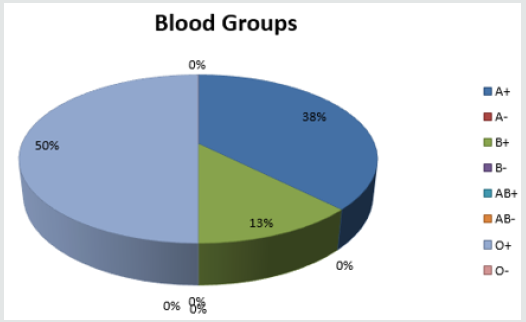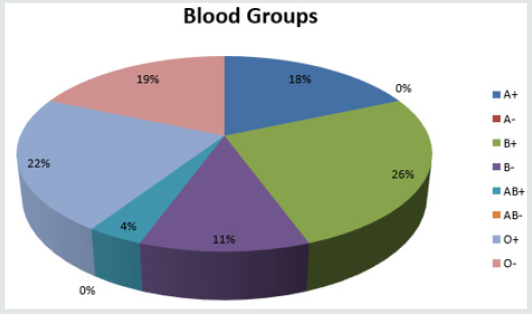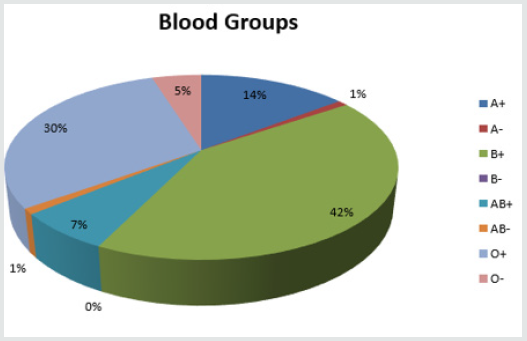Lupine Publishers | Journal of Health Research and Reviews
Abstract
Objective of the present study was to correlate blood grouping with chin dimple. A total of 173 subjects participated in this recent activity. The subjects were students in Bahauddin Zakariya University Multan, Pakistan. Agglutination in Antisera D showed positivity and negativity of blood group and Antisera A and B showed the blood group of person. It was concluded from present study that B+ female has high percentage of chin dimple and B- female; AB- male, O- male has low percentage of chin dimple.
Keywords: Blood group; Chin dimple; Butt chin; Cleft chin; Jaw bone; Factor of beauty
Introduction
International Society of Blood Transfusion presented the word ‘Human blood group system’. This blood group system includes ABO and Rh system. The blood group system is used to denote one, both, or neither of the A, B antigens. The ABO blood group system was presented by Karl Landsteiner, 1901. It is present in other animals such as rodents and apes. Blood groups are transmitted by both parents. Single gene controls this character with three types of alleles. IA allele gives A. IB allele gives B and I allele gives O. person having IA IA or IAi has blood group A. Person having IB IB or IBi has blood group B. IAIB has blood group AB. Group A will have antigens A and group B will have antigens B. Group AB has both antigens A and B. Group O has neither A nor B antigens in blood [1]. The Rhesus (Rh) system is named as when first discovered in Rhesus monkey. The presence of RhD antigen in the blood shows Rh+. And the absence of RhD antigen shows Rh-. The blood grouping is important for the blood transfusion. If the blood given to the patient is incompatible, then it will be fatal for patient. The body will produce antibodies that will attack the antigens of donor blood. Disadvantage of blood grouping is that there are greater chances of hepatitis and other diseases due to transfusion of blood [2].
The terms cleft chin, butt chin, or chin dimples have the same meaning as a dimple on a chin. This appears as a Y shaped cleft on the jaw bone. Chin crevice follows the cleft in jaw bone that is due to the incomplete fusion of jaw bone. This chin dimple is an inherited trait where the dominant genes causes this fissure. In the area of the thickest layer of the skin, muscle fiber present that joins with outer skin. The stretch occurs there, and it creates a dimple in a chin. This chin dimple is also considered as factor of beauty. The cleft in a chin appears in diversity including vertical crease, y shaped crease and round hollow in a chin. It can be in depth from a slightly visual crease to an extremely visual crease. The person having this trait usually gets the attention of people and remains in center of interest. People having chin dimple have certain characteristics as they have capabilities of leader. They are not afraid to take responsibilities and the owner of the chin dimple is strong man, tenacious and brave. Objective of the present study was to correlate blood grouping with chin dimple.
Materials and Methods
A total of 173 subjects participated in this recent activity. The subjects were students in Bahauddin Zakariya University Multan, Pakistan.
Blood Grouping
We had laid out all the components of the kit. We added a drop of antisera A, B and D to each circle on the Eldon card. We sterilized our finger with alcohol wipe and then pricked the fingers with the lancet. The tip of finger was squeezed to get a big drop of blood. Using one of the plastic tools in the kit, we transferred a drop of blood to one of the card circles. We did this for each circle. Blood and droplet were swirled together in each circle using the same plastic stick we used for gathering the blood. We compared circles of blood to determine which blood type we had. Note the precipitate formation. Antisera D showed the positivity and negativity of the blood. If coalescing occurs in antisera D, then blood group is positive and if doesn’t occur then negative. If the coalescing occurs in Antisera A and D, then it is A+ and if coalescing occurs only in Antisera A then it is A-. If coalescing occurs in antisera B and D, then it is B+ and if coalescing occurs only in antisera B then it is B-. If coalescing occurs only in Antisera D, then it is O+ and if no coalescing occurs in any of antisera then it is O-. If coalescing occurs in antisera A, B and D, then it is AB+ and if coalescing occurs in Antisera A and B, not in D then it is AB-. In this way, I tested my blood group and it was B+.
Project Designing
The topic of our project was chin dimple. We made a question and then asked to subject that either they had chin dimple or not. All the subjects answered the question, according to their blood group in their respective column.
Statistical Analysis
Statistical analyses were performed by using MS Excel.
Results
Possibility of chin dimple among different blood groups is given in Figures 1-4. These were pie chart having different percentage about presence or absence of chin dimple in different blood groups. Figure 1 showed that A+, B+ and O+ males had high ratio of chin dimple while Figure 2 showed that A+, A-, B+, B-, AB+ and O+ males had no chin dimple in them. Figure 3 showed that A+, B+, B-, AB+, O+ and O- females had chin dimples in them while Figure 4 showed that A+, A-, B+, AB+, AB-, O+ and O- had no chin dimples in them.
Discussion
Questionnaire based studies have given an important advancement in recent researches [3-10]. The ratio of chin cleft alters among population. According to Bhanu and Malhotra, who studied in 1972 that %age of chin dimple ranges from 4% to 71% in India. In 1939, Gunther observed the ratio of chin cleft that was 9.6% in German men and 4.5% in German women.
Conclusion
It was concluded from present study that B+ female had high percentage of chin dimple and B- female; AB- male, O- male had low %age of chin dimple.
For more Lupine Publishers Open
Access Journals Please visit our website:
http://lupinepublishers.us/
For more Research
and Reviews on Healthcare articles Please Click Here:
https://lupinepublishers.com/research-and-reviews-journal/
To Know More About Open Access
Publishers Please Click on LupinePublishers
Follow on Linkedin : https://www.linkedin.com/company/lupinepublishers
Follow on Twitter : https://twitter.com/lupine_online







No comments:
Post a Comment